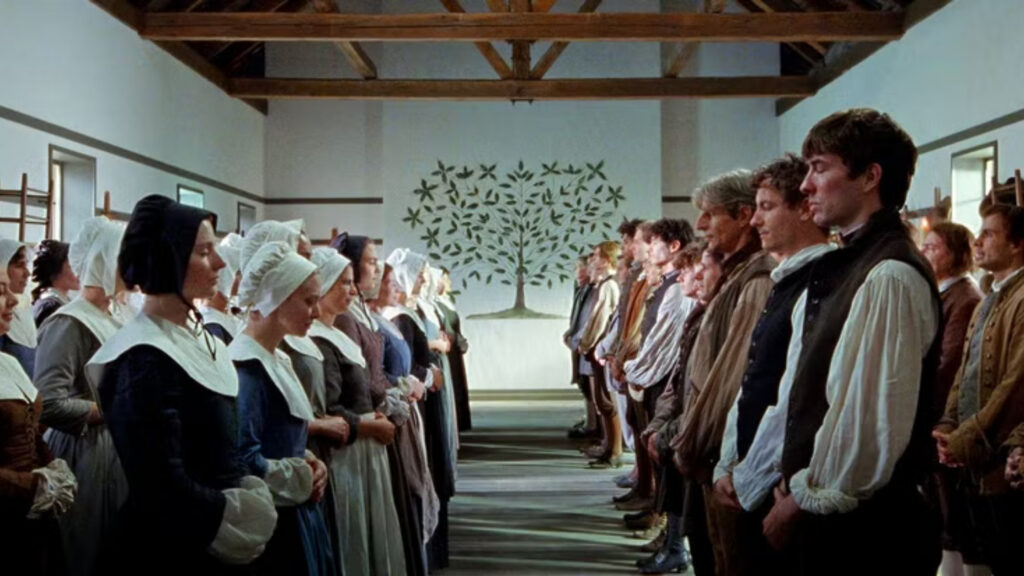Basic Info & Context.
Title: The Testament of Ann Lee.
Director: Mona Fastvold (co-writer with Brady Corbet)
Genre: Historical drama / musical / biopic about Ann Lee (founder of the Shaker movement) in the 18th century.
Runtime: 130 minutes.
Budget: around US$10 million.
Premiere: World premiere in competition at the 82nd Venice International Film Festival on 1 September 2025.
Distribution: Limited theatrical release in the U.S. on 25 December 2025.
Cast & Lead Character.
Cast
Some of the principal cast members are:
- Amanda Seyfried as Ann Lee.
- Lewis Pullman as William Lee (Ann’s brother).
- Thomasin McKenzie as Mary, a supporting character.
- Stacy Martin, Christopher Abbott, Tim Blake Nelson among others.
The full cast list is larger; credited supporting actors include many names (Matthew Beard, Scott Handy, Jamie Bogyo, Viola Prettejohn, David Cale).
Means Character.
The central viewpoint is Ann Lee herself (Amanda Seyfried). The story is anchored through her life: her early hardship, her spiritual crisis, her leadership of the Shaker movement, and her migration to the New World. Because the narrative follows her transformation and choices, and because S eyfried’s performance has been widely praised as the emotional core, Ann Lee is the means character of the film. Reviews emphasise that Amanda Seyfried “powers through” the role and carries the film.
Box Office & Commercial Context.
This is a film more oriented toward festivals, art cinema and prestige rather than mass-multiplex domination. Key financial points:
- Budget: ~US$10 million.
- As of current public data, there is no widely reported blockbuster box office figure. Because the film is still rolling out in limited release (25 December 2025 in U.S.), full box office numbers are not yet widely available.
- Reviews and festival reception suggest the film is intended for niche audiences and awards visibility, rather than major box-office returns.
In short: The “box collection” in the conventional sense is not yet publicly robust; the film’s measure of success is likely to include critical acclaim, festival awards, streaming distribution and cultural impact rather than large commercial profit.
Niche, Tone & Thematic Domain.
Genre / Niche
The Testament of Ann Lee occupies a rare niche: a historical musical drama / spiritual biography. It blends elements of period drama (18th-century England and colonial America), religious movement biopic (Shakers), and musical/ritualistic expression (song, dance, ecstatic worship). Reviews describe it as a “musical, but not really a musical; a religious biopic, but not quite.”
It appeals to audiences interested in:
- historical, faith-based narratives
- female leadership in religious movements
- art-film sensibilities (festival circuit, experimental musical style)
- character studies of transformation and identity
Tone & Themes
The film’s tone is ambitious, evocative, often unsettling. Key themes include:
- Faith and conviction: Ann Lee’s transformation into a religious leader, her belief in celibacy, spiritual community, self-sacrifice.
- Otherness and radical spirituality: The Shakers, led by a woman in the 18th century, dancing and shaking in worship — a radical form of community in an era of hierarchy and repression.
- Migration and utopian impulse: Ann Lee and her followers’ journey from England to America, building a new community.
- Gender, repression, and power: The The Testament of Ann Lee film doesn’t shy away from showing childbirth trauma, sexual repression, patriarchal structures.
- Ritual, worship, and aesthetic intensity: The movement of bodies in worship, the musical/ritual sequences, the visual and sonic ambition of the film.
The niche is thus art-house historical/faith cinema with musical underpinnings. It’s not mainstream action or mass entertainment; it’s meditative, richly styled, reflective.

Deep Narrative & Analysis.
Story Structure & Key Beats
The The Testament of Ann Lee film traces Ann Lee’s life in three broad acts, from childhood in Manchester to religious leadership in America. Reviewers highlight this structure: childhood/England → journey/new world → final years/legacy.
Act I – Origin & Breakaway:
Ann Lee grows up in 18th-century Manchester, England, in poverty. She bears four children who all die in infancy — a traumatic passage for her and the foundation for her later spiritual path. She witnesses religious fervour (the Quaker “shaking” worship) and then begins her own radical path, rejecting conventional marriage and bodily life.
Act II – Movement & Mission:
Lee becomes leader of a group of believers who call themselves the Shakers. Her message: celibacy, equality, community, radical devotion. She and her followers emigrate to America, facing persecution, building their utopian community against the backdrop of the revolutionary era. The The Testament of Ann Lee film shows their ecstatic worship, dancing and shaking as spiritual expression.
Act III – Legacy & Reckoning:
The final act addresses the toll: the sacrifices, the interpersonal costs, the tension between ideal and reality. The movement’s radical stance (e.g., pacifism during the Revolutionary War) and Ann’s role as female spiritual authority create conflict. The The Testament of Ann Lee film doesn’t simplify her: it offers a complex portrait of someone both revered and contested.
What Works
- Amanda Seyfried’s performance is widely praised as a breakout, career-best role. She channels Ann Lee’s intensity, spirituality and embodiment of leadership.
- The visual and musical ambition: The The Testament of Ann Lee film uses actual Shaker hymns as part of its score, and the worship sequences are visceral, physical, haunting. Reports note the bodies shaking, the soundscape, the immersion.
- The film’s willingness to be ambiguous: It does not fully endorse or condemn Ann Lee but invites sympathy, curiosity and reflection. The Guardian review calls it “a genuinely strange film, elusive in tone and meaning.”
What May Challenge Viewers
- The tonal ambiguity: Because it blends musical elements with spiritual history, some audiences may find the hybrid style disorienting — “not really a musical, not really a biopic.”
- The intensity of worship/ritual sequences: Reviewers note some scenes are visceral, disturbing, involving childbirth, ecstatic dance and bodily extremes — this may be off-putting to viewers expecting a standard historical drama.
- The commercial reach: As an art-house film with a modest budget and limited release, its narrative depth and stylisation might not translate into broad mass-market appeal.
Why This The Testament of Ann Lee Film Matters.
- It spotlight’s a female religious figure often overlooked in mainstream cinema: Ann Lee, founder of the Shakers, a radical woman leader in the 18th century. The film thus contributes to expanding historical narratives about women and spirituality.
- The film explores how belief, community, and body intersect: by dramatizing ecstatic worship and communal life, it offers a cinema of spirituality rarely seen in contemporary films.
- In a film era dominated by franchises and spectacle, The Testament of Ann Lee stands out as a bold, mid-budget, artistically ambitious film — reminding us that niche/historical/spiritual stories still have space.
- It may become a reference point for discussions about how musicals and period dramas can merge.
Final Thoughts of The Testament of Ann Lee Movie.
The Testament of Ann Lee is a demanding, deeply felt film. If you’re open to something more than entertainment — a film that makes you feel worship, zeal, community and tension — you’ll likely find much here to admire. It doesn’t offer tidy resolutions. It trusts its lead performance, its visual and sonic textures, and its viewer’s willingness to engage.
For those who prefer clean genre lines, straightforward narrative and familiar biopic tropes, this film might feel disjointed or challenging. But for readers of history, religion, women’s stories, art-film musicals — this is a rich, memorable work.





